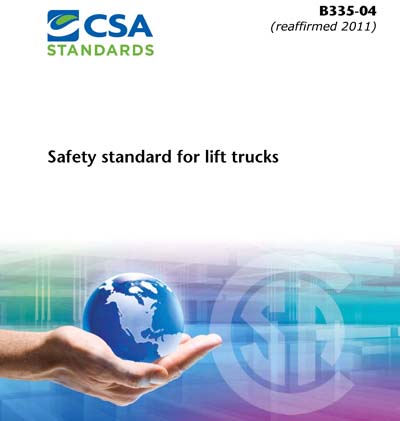Historical
CAN/CSA B335-2004 (R2012)
CAN/CSA-B335-04 (R2012) - Safety Standard for Lift Trucks
Update #1 was published as notification that this is now a National Standard of Canada.
Update(s) to this standard are available. To download any updates and/or register for email notification of future updates click here.
1. Scope
1.1 This Standard applies to lift truck Classes 1, 2, 3, 4, 5, and 7; in addition, certain clauses apply to Class 6 vehicles, non-powered high lift trucks, and personnel and burden carriers. See Annex B for a listing and description of classes.1.2 The purpose of this Standard is to promote lift truck safety and minimize the risk of injury to workers by specifying the essential elements of a lift truck safety program and prescribing requirements with respect to lift truck design and construction, maintenance and inspection, safe operation, and operator training.
This Standard also outlines recommended qualifications for trainers and maintenance technicians.
This Standard can also be used as a guide for Canadian federal, provincial, and other regulatory bodies in the development and promulgation of appropriate health and safety legislation and directives concerning lift trucks.
1.3 Clause 4 of this Standard specifies the key elements of a lift truck safety program, including general medical and physical fitness requirements for lift truck operators.
1.4 Clause 5 of this Standard sets forth safety standards for the design and construction of lift trucks at the time of manufacture.
1.5 Clause 6 of this Standard provides minimum requirements for initial and ongoing familiarization and upgrade training in the operation of lift trucks, including any of their attachments. Notes: (1) Due to the different design of vehicles classified as Class 6, non-powered high lift trucks, and personnel and burden carriers, only certain parts of Clause 6 will be relevant; however, appropriate training for these classes is to be provided to operators of said equipment. (2) Job and/or familiarization training of lift truck operators for particular lift trucks requiring special needs or specialized equipment and/or used in a specific workplace environment are in addition to the basic training requirements of this Standard.
1.6 Clause 7 of this Standard outlines the minimum qualifications for a trainer delivering a lift truck operator training program as outlined in Clause 6.
1.7 Clause 8 of this Standard covers inspection, maintenance, and repair of lift trucks and their attachments.
1.8 Clause 9 of this Standard outlines the minimum qualifications for a maintenance technician inspecting and maintaining a lift truck as outlined in Clause 8.
1.9 In this Standard, shall is used to express a requirement, i.e., a provision that the user is obliged to satisfy in order to comply with the standard; should is used to express a recommendation or that which is advised but not required; may is used to express an option or that which is permissible within the limits of the standard; and can is used to express possibility or capability.
Notes accompanying clauses do not include requirements or alternative requirements; the purpose of a note accompanying a clause is to separate from the text explanatory or informative material. Notes to tables and figures are considered part of the table or figure and may be written as requirements. Legends to equations and figures are considered requirements. Annexes are designated normative (mandatory) or informative (nonmandatory) to define their application.
1.10 The values given in SI (metric) units are the standard. The values given in parentheses are for information only.
CSA America, Inc. [csa]

